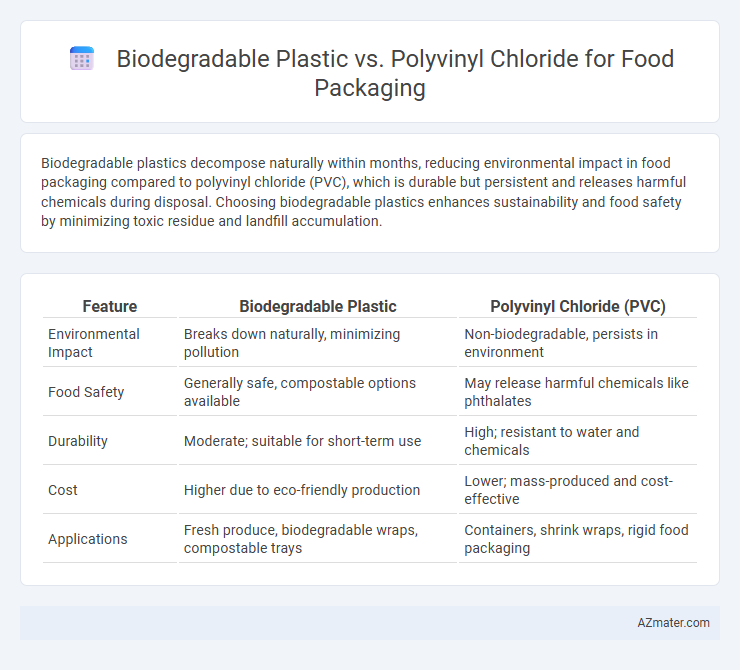Biodegradable plastics decompose naturally within months, reducing environmental impact in food packaging compared to polyvinyl chloride (PVC), which is durable but persistent and releases harmful chemicals during disposal. Choosing biodegradable plastics enhances sustainability and food safety by minimizing toxic residue and landfill accumulation.
Table of Comparison
| Feature | Biodegradable Plastic | Polyvinyl Chloride (PVC) |
|---|---|---|
| Environmental Impact | Breaks down naturally, minimizing pollution | Non-biodegradable, persists in environment |
| Food Safety | Generally safe, compostable options available | May release harmful chemicals like phthalates |
| Durability | Moderate; suitable for short-term use | High; resistant to water and chemicals |
| Cost | Higher due to eco-friendly production | Lower; mass-produced and cost-effective |
| Applications | Fresh produce, biodegradable wraps, compostable trays | Containers, shrink wraps, rigid food packaging |
Introduction to Food Packaging Materials
Biodegradable plastics and polyvinyl chloride (PVC) are prominent materials in food packaging, each offering distinct properties suitable for different applications. Biodegradable plastics provide sustainable alternatives with the ability to break down in natural environments, reducing environmental impact and aligning with increasing consumer demand for eco-friendly packaging. Polyvinyl chloride, known for its durability, excellent barrier properties, and cost-effectiveness, remains widely used in food packaging despite environmental concerns related to its production and disposal.
Overview of Biodegradable Plastics
Biodegradable plastics, primarily derived from renewable biomass sources such as corn starch, cellulose, or polylactic acid (PLA), offer an eco-friendly alternative to conventional plastics in food packaging by decomposing naturally through microbial activity. These plastics reduce environmental impact by minimizing long-term pollution and facilitating composting, making them suitable for single-use food containers and wraps. Their performance in barrier properties and durability is improving, though they currently lag behind polyvinyl chloride (PVC) in strength and moisture resistance.
Understanding Polyvinyl Chloride (PVC)
Polyvinyl Chloride (PVC) is a widely used thermoplastic in food packaging due to its strong barrier properties, durability, and clarity, making it ideal for preserving freshness and extending shelf life. PVC's chemical resistance and flexibility allow it to be easily molded into films and containers, providing effective protection against moisture, oxygen, and contaminants. Despite its functional benefits, PVC raises environmental concerns related to its non-biodegradability and potential release of hazardous additives during disposal or incineration, prompting a search for sustainable alternatives like biodegradable plastics.
Environmental Impact: Biodegradable Plastics vs. PVC
Biodegradable plastics significantly reduce environmental pollution by breaking down naturally within months to years, minimizing landfill accumulation and harm to marine ecosystems. Polyvinyl chloride (PVC) poses serious environmental risks due to its persistence, toxic additives like phthalates, and hazardous chlorine content that can release dioxins during incineration or decomposition. Life cycle assessments reveal biodegradable plastics generate lower greenhouse gas emissions and less toxic waste compared to PVC, making them a more sustainable choice for food packaging.
Food Safety and Health Considerations
Biodegradable plastics used for food packaging often contain fewer harmful additives compared to polyvinyl chloride (PVC), reducing the risk of toxic chemical migration into food products. Polyvinyl chloride can release hazardous substances like phthalates and dioxins, which pose potential health risks including endocrine disruption and carcinogenic effects. Choosing biodegradable alternatives enhances food safety by minimizing exposure to these harmful compounds during storage and handling.
Performance and Durability in Packaging
Biodegradable plastics offer moderate performance and durability for food packaging, providing sufficient barrier properties against moisture and gases but generally exhibiting lower mechanical strength and heat resistance compared to polyvinyl chloride (PVC). PVC excels in durability with high tensile strength, chemical resistance, and excellent clarity, making it ideal for extended shelf life and protection of perishable foods. However, ongoing advancements in biodegradable polymer composites aim to bridge the gap, enhancing their structural integrity and barrier effectiveness while maintaining eco-friendly benefits.
Cost Analysis: Biodegradable Plastics versus PVC
Biodegradable plastics typically have higher production costs compared to polyvinyl chloride (PVC) due to raw material expenses and less mature manufacturing processes. PVC remains cost-effective for food packaging because of its widespread availability, durability, and established supply chains. However, the increasing environmental regulations and consumer demand for sustainable products are narrowing the cost gap between biodegradable plastics and PVC.
Regulatory Standards and Compliance
Biodegradable plastics for food packaging must comply with stringent regulatory standards such as ASTM D6400 and EN 13432, ensuring they break down safely without harming food safety or the environment. Polyvinyl chloride (PVC) packaging faces strict controls from agencies like the FDA and EFSA due to concerns over plasticizer migration and potential toxin release, requiring compliance with specific migration limits (SMLs) and heavy metal restrictions. Both materials undergo rigorous testing for food contact safety, but biodegradable plastics benefit from evolving regulations promoting sustainability and reduced environmental impact.
Consumer Preferences and Market Trends
Biodegradable plastics are rapidly gaining consumer preference in food packaging due to increasing environmental awareness and demand for sustainable products, influencing market trends towards eco-friendly solutions. Polyvinyl chloride (PVC), while durable and cost-effective, faces declining favor because of health concerns and environmental impact associated with chlorine content and recyclability challenges. Market data shows a significant rise in biodegradable packaging adoption in Europe and North America, driven by regulatory policies restricting single-use plastics and growing consumer demand for green alternatives.
Future Outlook for Sustainable Food Packaging
Biodegradable plastics offer promising advancements in sustainable food packaging by reducing environmental impact through natural decomposition, contrasting with Polyvinyl chloride (PVC), which poses challenges due to its persistence and potential release of harmful chemicals. Innovations in biodegradable polymer composites and edible coatings are set to enhance the functionality and safety of food packaging while meeting increasing regulatory demands for eco-friendly materials. Market trends indicate a growing consumer preference for sustainable options, driving research investment and policy support towards biodegradable alternatives over traditional PVC-based packaging.

Infographic: Biodegradable plastic vs Polyvinyl chloride for Food packaging
 azmater.com
azmater.com